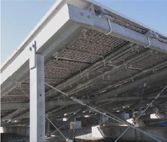July 2, 2011
Company, University Begin Experiments to Cool Solar Cells for Improving Efficiency
Keywords: Environmental Technology Manufacturing industry Renewable Energy University / Research institute

Copyright LIXIL Corporation
LIXIL Corporation, a major Japanese manufacturer of building materials and housing equipment, and Daido University, located in Nagoya, Aichi Prefecture, began on March 25, 2011, a feasibility study of a system that uses water retention ceramics to improve solar power efficiency. Demonstration tests of the system will be conducted using a polycrystalline silicon solar power system installed in the Aichi Rinku New Energy Research Area.
A major drawback of the polycrystalline silicon solar cells, a major technology for solar power generation, is that its generation efficiency decreases as temperature rises. Particularly during the summer, when the surface temperatures of solar modules rise to about 60 degrees Celsius, its generation efficiency decreases by at least 10 percent. To solve this problem, LIXIL and Daido University have been conducting joint research aimed at cooling down solar cells using a water retention ceramics developed by LIXIL as eco-friendly material.
The ceramics have a high water-holding capacity (more than 60 percent water retention) and high evaporation ability due to its capillarity. For this reason, the ceramics have been used in demonstration tests to develop technologies to mitigate the effects of unpredictable torrential rain and urban heat island. Ceramic pieces are pressed against the back of the solar modules, and water is sprayed onto the ceramics. The water stored within the ceramic evaporates and extracts heat, thereby cooling the solar cells and improving their power generation efficiency.
In the demonstration tests, LIXIL and Daido University will collect data on the output of 2.5-kilowatt solar panels under six different conditions (using different spraying methods and different shapes of ceramic pieces) simultaneously. By doing so, they aim to identify the type of water retention ceramics that has the highest cooling effect, as well as the most efficient system for improving solar power generation. They plan to announce the final results of the study in March 2013.
Daido Steel Building Pilot Plant that Concentrates Solar Energy to Make Electricity (Related JFS article)
http://www.japanfs.org/en/pages/028686.html
Posted: 2011/07/02 06:00:15 AM
Reference
LIXIL Global website
http://global.lixil.co.jp/
Related
"JFS Newsletter"
Related
"Popular Articles"
- New Nano-Bubble Technology May Help Dissolve Sludge and Improve Water Quality
- Japanese Firm Begins Development of Tidal Power Generation System
- Small Hydropower Generation System Developed for Use in Seawater, Weight Cut by Half
- Constructed Wetland Facility Established by Japanese University Purifies Livestock Farming Drainage
- Toyota CRDL Succeeds in World's First Artificial Photosynthesis Using only Water and CO2


